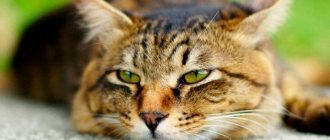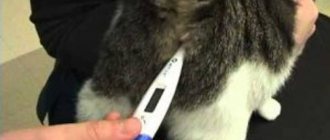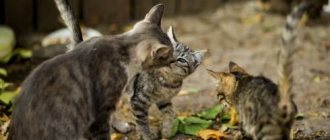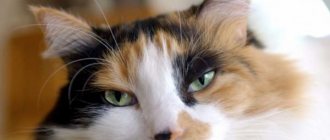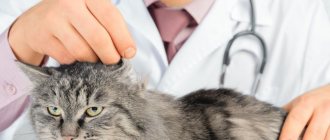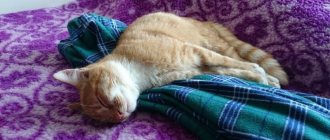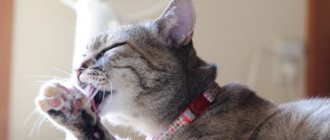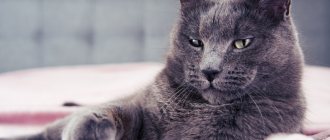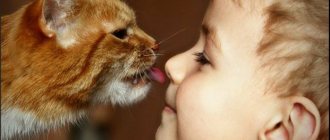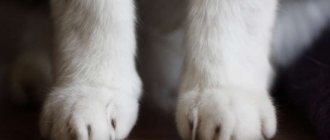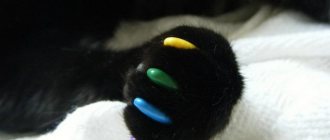When a cat's claws peel off, she experiences discomfort and begins to sharpen them on various objects. This is done in order to remove the exfoliated membrane from the nails. Animals living outside use trees for this. Pets scratch everything that gets in their way. Furniture, wallpaper, doors are used. However, you should not be angry with the kitten, as this is a normal physiological process.
The main causes of claw separation
In order to make a correct conclusion about the cat’s health, you need to find out the possible causes of claw separation:
- As they grow, the claws begin to fall apart. Therefore, very often during growth, the old stratum corneum disappears and a new one grows. In this case, the cat needs to be provided with a specific place where it will scratch its claws.
- If (soon) during the grooming procedure your furry pet's claws were cut incorrectly, this can also cause delamination. Perhaps the haircut was cut too briefly or a blunt instrument caused injury.
- A common cause is the deterioration of vitamins and essential microelements in the cat’s body. Nutritional deficiency initially affects the condition of the animals’ fur and claws.
Nails are peeling
Iron deficiency
Syphilis
Menopause
Climax
Diabetes
9682 09 December
IMPORTANT!
The information in this section cannot be used for self-diagnosis and self-treatment. In case of pain or other exacerbation of the disease, diagnostic tests should be prescribed only by the attending physician. To make a diagnosis and properly prescribe treatment, you should contact your doctor. Nail separation:
causes of occurrence, what diseases it occurs with, diagnosis and treatment methods.
Description
Nail delamination is a violation of the homogeneous structure of the nail plate, leading to its splitting into separate leaf-like scales. This condition refers to nail dystrophies, in which changes in the shape and structure of the nail plate are associated with a violation of the cellular nutrition of the nail.
Nails are horny (or keratinous) formations consisting of β-keratin, which determines their lamellar or layered structure. Keratin is one of the strongest proteins, second only to chitin - it is resistant to acids, alkalis, high and low temperatures. The composition of nails also includes water, cholesterol, sulfur, calcium, phosphorus, zinc, and selenium. A healthy nail plate is transparent, smooth, shiny, 0.3-0.4 mm thick.
Layers of keratinized horny cells of the nails are formed from the outer germ layer of the embryo (ectoderm) from the end of the 3rd month of intrauterine development. First, the nail bed is formed, then the nail folds and nail skin, and at 7-8 months the nail plates are formed. Thus, nail pathologies may be associated with malformations of the ectoderm.
The nail plates on the hands and feet originate from the matrix area located at the base of the nail. The white crescent-shaped area of the nail root is the visible part of the nail matrix. Nail growth occurs due to the division of germ cells in the matrix, which gradually “push” the old nail plate forward. The structure, shape, thickness and growth rate of the nail depend on the condition of the matrix. The hardness and density of the nail plate is affected by the amount of cysteine, a sulfur-containing amino acid. Between the layers of keratin there are layers of water and fat, giving the nails shine and elasticity.
Types of nail separation
- Onychoschisis is a separation of the nail in the transverse direction.
- Onychorrhexis is the separation of nails in the longitudinal direction.
- Onychomadesis is a separation of the nail on the side opposite the free edge.
- Onycholysis is complete or partial detachment of the nail from the nail bed.
Possible causes of peeling nails
The appearance of fingernails and toenails in many cases is an indicator of the health of the body as a whole, since changes in the nail plates can be a consequence of the influence of not only external factors, but also internal ones.
This or that type of nail separation is not characteristic of a particular disease, therefore, with the same pathology, different peeling nails can occur. For example, with lichen planus, the dissection can occur in both the longitudinal and transverse directions.
Exogenous causes of nail separation can be chemical and/or physical factors: contact with acids, alkalis, oil, improper manicure and pedicure techniques, tight shoes.
In women who are overly keen on manicure, nail dystrophy can result from exposure to varnish and acetone; In musicians who play string instruments, with frequently repeated injuries to the free edge of the nail, it becomes abraded, wears out, and edge defects form.
The habit of biting nails (onychophagia) leads to shortening, cracking and splitting of nails. In addition, infection and the development of an inflammatory process are often noted.
Unbalanced nutrition, stress, skin and chronic diseases, infections, fungal nail infections, hormonal imbalance, the influence of certain medications, lack of vitamins and minerals can be endogenous factors in the occurrence of nail separation.
With skin diseases such as psoriasis, eczema, lichen planus, in addition to nail separation, pits often appear with a diameter of a few tenths of a millimeter to 1-1.5 ml and a depth of up to 1 mm. In this case, cracks form at the bottom of the longitudinal grooves, starting from the free edge of the nail, often reaching its proximal part. Individual nails or all fingernails may be affected. Toenails are less commonly affected.
With eczema, peeling of the nails in small thin plates is often observed. Deformation of the nail plate depends on the degree of damage to the nail fold and matrix. Often, due to severe inflammatory processes, the nail skin disappears. In severe cases, complete rejection of the nail plate from the nail bed may occur. With acute eczema of the skin of the hands or feet, there is pain, burning and itching in the area of the nail bed and the skin of the nail phalanges.
In psoriasis, nail damage can manifest itself long before the formation of psoriatic plaques on the skin and, until a certain time, serve as the only manifestation of the disease.
With bullous dermatoses (pure pemphigus, congenital epidermolysis bullosa, chronic acrodermatitis Allopeau, etc.), the nails are deformed and may have transverse marks, striations, longitudinal grooves, depressions and splits starting from the free edge.
Changes in nails occur in case of infection with a fungus and are characterized by redness of the nail fold - it becomes cushion-shaped and hangs over the nail. There may be scanty, crumbly discharge from under the nail fold, the nail plate becomes brownish-brown in color, its surface has transverse grooves, bulges and/or depressions. Spots that are whitish-gray, yellow, or dirty gray and round or irregular in shape may appear. Nails become thinner, brittle, and partially separate from the nail bed.
Damage to the nail plate often occurs in patients with syphilis. Changes in the nail plate depend on the severity of damage to the periungual fold, which occurs both in the primary period of syphilis and in later stages of the disease. The nail may have transverse grooves of varying depths, be lumpy, lose transparency, become thinner, crack at the free edge, and may separate from the nail bed.
Splitting of nails often indicates a lack of nutrients in the body, which can arise both as a result of insufficient intake from food and as a result of diseases of the gastrointestinal tract.
The splitting of nails is affected by a deficiency of B vitamins. The lack of niacin (vitamin B3) leads to their slow growth, the lack of vitamin B6 causes fragility, dryness and peeling, biotin (vitamin B7) directly affects the splitting of nails. Vitamin C promotes the formation of collagen - the basis of connective tissue, ensures the strength and elasticity of nails, so its lack is also fraught with delamination.
A lack of vitamins E and D can also lead to brittle and split nails.
In addition to vitamins, a number of microelements (silicon, selenium, iron, calcium, magnesium, zinc) are necessary for the strength of nails. In iron deficiency, dystrophy of the nail plate is observed.
Endocrine and metabolic disorders are diseases whose clinical picture may be accompanied by nail deformation. Diabetes mellitus, hyperthyroidism (increased thyroid function), hypothyroidism (low thyroid function), pregnancy, menopause (cessation of menstrual cycles in women) cause changes in the condition of the nails.
Which doctors should I contact if my nails are split?
To identify or exclude diseases that provoke splitting of nails, you may need to consult a dermatologist or mycologist.
Diagnostics and examinations for nail splitting
Often, to detect the exact cause of nail separation, a whole range of laboratory and instrumental diagnostic methods is required, from which the doctor selects the necessary ones.
- Diagnosis of diabetes mellitus:
- comprehensive ultrasound examination of the abdominal organs (liver, gall bladder, pancreas, spleen);
What does an ingrown claw look like and what signs can you use to suspect a problem?
Ingrowth leads to discomfort and pain in the paw, which is manifested by changes in the pet’s behavior:
- he often licks the pad and tries to gnaw out the claw;
- his gait changes - the cat steps carefully, becomes less mobile, and limps;
- sometimes in the places where he passed, you can see traces of blood;
- upon examination, a strongly grown, bent claw is discovered that has dug into the soft tissue (see photo above), sometimes the pad swells and turns red;
- if an abscess begins, pus is released and an unpleasant odor appears, the limb becomes hot;
- When you touch a problem area, the cat becomes anxious, breaks away and tries to bite.
How to help your cat overcome split claws
There are several ways to help your cat deal with the problem of split claws:
- If a mustachioed dog has lost its claws, then a scratching post will help him cope with this problem perfectly. You can choose a floor-mounted, wall-mounted or corner scratching post, which is made of various materials that your kitten will like. Place it in your pet’s favorite place, and he will easily and independently get rid of the exfoliated shell, because of which he experiences discomfort every time he retracts his claws into his paw.
- In the case when you decide to cut the nails yourself, then for the first time it is better to contact a veterinarian, he will tell you and show you how to do it correctly so as not to harm your pet. After all, if after a haircut the cat’s claws begin to peel off, this is not the worst thing that could happen. It will be much worse if you touch the nerve endings with careless and incorrect circumcision, and the cat will experience unbearable pain. You can also provoke bleeding or inflammation of the cat’s claws, and then you definitely won’t have any problems.
- If your pet regularly uses a scratching post and you trim each nail correctly and efficiently, and the problem with delamination of the claws has not gone away, then you should still pay attention to its nutrition. You need to know that in this case the cat lacks vitamins and her claws peel off.
What to do when claws come apart
The first step is to recognize the cause. In the meantime, you need to prepare a specific place for your pet to sharpen its claws, otherwise your favorite Chesterfield or chair may suffer. You can purchase a special scratching post in the store. If it's all about the growth of the claws, then this will be a good way to get rid of the dead stratum corneum. Another good way for Wotan is to put special silicone attachments on the cat’s claws. Anti-scratch attachments are made of soft material and are completely harmless to animals. Recycling them will help you protect your furniture and home decorations from cat attacks.
So that improper haircut does not cause the claws to separate, it would not be a sin or something. do the procedure carefully. If it is not possible to invite a specialist, and your sister decides to trim her nails on her own, then it is important not to disturb the blood vessels. Only the very tip needs to be trimmed. All the more, if you touch a blood channel, you can cause pain to the cat. Not all animals easily experience stress. Some breeds may become ill from the resulting stress and will need treatment.
When, after observations, you come to the conclusion that the cause of the separation is the imperfection of nutrients, then you need to take action. Your cat's diet should include special supplements containing various vitamin complexes. God ordered such supplements to be purchased in a special store that sells animal food. It is advisable to seek advice from a veterinarian who will prescribe the proper nutrition for your pet. OCD of poor nutrition can cause problems such as claw diseases.
What to do
There are several ways to solve the problem of claw separation:
- Scratching post. This unit will help the cat to independently get rid of the exfoliated shell of the claws by pointing them. The claw grinder can come in various shapes and sizes. They can be mounted on a wall, the back of a sofa, or any other place that the cat chooses for a claw point.
- Trimming nails. This procedure should be carried out very carefully so as not to damage the claws or cause bleeding and even greater separation. For the first time, it is better to contact a veterinarian who will trim the ends correctly and teach you how to do it yourself.
Tip: When trimming your pet’s nails yourself, you need to be careful and trim only the very tip. If you cut off more than necessary, you can touch the cat’s nerve endings and hurt her. In some cases, this can even lead to bleeding and inflammation.
- Claw attachments. If your cat's claws are peeling off, try purchasing these attachments. They are made of soft silicone and serve to protect both the cat's claws and furniture and other objects that can be used for the point. They do not cause discomfort to the pet and protect its owners and interior items from scratches.
You can choose any color from the anti-scratch pads.
But with an existing scratching post and regular trimming, you will still notice a clearly even separation of the claws. You may just need to feed your cat a balanced diet and give her extra vitamins for healthy nails. Only then will you and your pet forget about unnecessary stratification.
To completely forget about the problem of peeling claws in a cat and the negative consequences of this problem, pay attention to Anti-scratch. These products are made of soft silicone and are absolutely safe for your pet. They simply attach to the claws and prevent the cat from scratching everything he sees in his path, be it furniture or a small child. This product has many color options, which will allow you to choose it exactly to match the color of your pet.
Help at the veterinary clinic
The extent of surgical intervention is determined by the doctor after a thorough examination of the animal. He evaluates the depth of the ingrowth, the degree of inflammation, and the general condition of the cat. If there are no complications, the doctor removes the problematic nail with a special tool, having previously treated the pad with an antiseptic. If inflammatory processes have already begun to develop, the operation is performed under local anesthetic. During the procedure, the veterinarian opens the abscess to remove the claw, pus, and clean out the wound. But very advanced cases require general anesthesia.
Similar article: Main symptoms and rules for treating microsporia in cats
After the manipulations, the doctor applies a sterile bandage with antibacterial ointment to the furry patient. To neutralize the inflammatory process, he prescribes a course of antibiotics, and for a speedy recovery, he prescribes mineral and vitamin complex preparations. If the animal is too weakened, it adds drugs that strengthen the immune system to the treatment regimen.
During the rehabilitation of the furry, it is necessary to regularly change the bandages. At the same time, you should not glue them with adhesive tape, so as not to further injure the surrounding tissues. If the cause of an ingrown toenail is genetic, the problem is likely to recur. During a relapse, it is best not to treat the animal yourself, but to contact a veterinarian for a second course of treatment.
After the manipulations, the doctor applies a sterile bandage to the cat.
Proper nutrition – what to include in your pet’s diet
If your cat's nails are split, immediately review your pet's daily menu. You should not delude yourself and believe beautiful advertisements - even the most balanced food will not replace ordinary meat, vegetables, fish, and dairy products. A pet's diet should consist of the following products:
- fresh meat;
- boiled vegetables;
- fish (fresh river fish is not recommended; it is better to boil it first, otherwise there is a risk of infecting the animal with worms);
- porridge;
- soups (remove fat first);
- dairy products (do not give milk in its pure form, the cat may develop diarrhea).
It would be a good idea to introduce vitamin complexes into the diet, especially if owners prefer to pamper their pet with store-bought food. It is better to find out from your veterinarian which vitamins are responsible for the good condition of the nail plates. You can replace vitamins with cereals, which contain all the elements necessary for a pet. Most often, oats are used, which are recommended to be pre-sprouted. You need to add chopped greens to your main feed at least once a week. For an adult cat, the dosage of green gruel is at least 15 g.
Important! Be sure to include cod liver in your cat’s diet, which contains substances necessary for good growth and to prevent cracking of nail tissue. Do not heat treat the product; during cooking, some of the beneficial elements disappear.
Usually, regular nail trimming, proper diet and frequent walks, which allow the cat to wear off dead tissue, are enough to forget about the problem for a long time. If this does not happen, the nail plates continue to separate, and you will have to give up trying to help your pet on your own and go to the veterinarian.
Claw diseases in cats
Animals, like people, are susceptible to various types of diseases. Therefore, it is recommended to regularly check with a veterinarian and have your pets vaccinated on time. There are a whole range of diseases that cause cats’ claws to be in poor condition and worsen their mood.
Fungal diseases can cause a weakened cat's immune system, causing scabs and dark spots to appear. When an animal develops a disease, its body weakens and, as a result, its claws become separated. If you notice suspicious symptoms in your pet, it is advisable to immediately go to the veterinary clinic. The veterinarian will prescribe supervision. And soon your Muska or Barsik will again delight you with fun games.
In order to avoid health problems in animals, owners must inevitably be more attentive, and if a problem arises, immediately take the necessary measures to solve them. The facial appearance and well-being of the cat will depend on this.
Cat claw care
If you care about the health of your furry pet, caring for your cat’s claws should be regular and correct. Be sure to buy one or more scratching posts, tools for trimming, hygiene, and polishing claws.
Important! If you have no experience, have your nails trimmed by a groomer or veterinarian. The procedure for trimming claws is carried out as they grow, approximately every three to five weeks.
Systematically inspect the cat's claws and paws for wounds and damage. Pay attention to your diet. Always wash your pet's paws after a walk. If you notice even minor damage to the paws, treat them with any antiseptic solution.
Symptoms and possible complications
It is quite easy to notice an ingrown claw in your pet. The problem is indicated by atypical behavior of the pet:
- Since the sharp tip of the nail injures the soft tissues, the animal develops noticeable lameness. Painful sensations do not allow the cat to fully step on the damaged paw, and therefore he begins to limp.
- The pet pays a lot of attention to the sore limb. He constantly licks his foot and tries to bite off the offending nail with his teeth.
- The pet becomes inactive, lies down more, and does not show interest in regular games.
If you notice uncharacteristic behavior, you need to carefully examine your pet's paws. An ingrown nail is usually longer than the rest, strongly curved, and often stuck into soft tissue. When a mechanical impact is applied to the pad, the cat becomes aggressive, hisses, bites, and tries to escape from the hands.
Related article: Why does a cat lose hair and develop bald spots?
Pet constantly licks foot
If the problem is not corrected, it can adversely affect the quality of life of the furbaby:
- he will have a constant feeling of discomfort;
- pain or discomfort;
- habitual activity and mobility will be forced to decrease;
- lameness and unsteadiness of step will appear.
When an infection gets into the wound, inflammation often begins. If no action is taken, an abscess may develop, which can lead to sepsis.
Claw growth
All domestic cats are known to have the ability to retract their claws. So, when there are particles of dead surface on a cat’s claws, the animal begins to experience unpleasant sensations when retracting its claws. It is for this reason that your pet may begin to sharpen its claws on your favorite sofa if you have not taken care to organize a separate place for this process. Also, through this action, cats mark their territory, since on their paws, in the area of the claws, there are glands that secrete an odorous substance that is not accessible to the human sense of smell, but is remarkably detected by the noses of other cats.
Why do they release claws?
It often happens that the cat marks time or lies on its knees and releases its claws at this time. Why a cat releases its claws is very important to know. After all, many owners begin to trim their cat’s claws and scold her when she puts out her claws at the wrong moment, but this is not recommended.
In fact, the phenomenon when a cat moves its paws and this is accompanied by the release of its claws is called a “milk step”. This comes from childhood, when kittens, when feeding on mother's milk, press on the mother's mammary glands with similar movements. Usually a milk step is a sign of affection from a cat, so you should never scold it. If these movements cause you discomfort, simply purchase soft silicone claw attachments.
How to train a cat to use a scratching post
Training is best started at an early age. But adults also make good friends with the new “simulator”.
To stop an animal from damaging furniture, you can spray it with water during each act of vandalism. You can also rub the furniture with orange or lemon peel - cats cannot stand the smell of citrus fruits. If your cat flatly refuses to approach the scratching post, rub the surface with catnip or a spray based on it. A cat's reluctance to sharpen its claws where they should be may be due to an unsuitable scratching post. It may be too loose or smooth. Sometimes it is worth changing several accessories to find one that your pet will like.
Causes of nails growing into the pad
Cats that are outdoors constantly wear down their claws on their front paws on tree trunks, and on their back paws they usually get worn down when walking. Domestic cats that never go outside rip off their owners' wallpaper, door frames, sofas and armchairs. To prevent this from happening, many people purchase scratching posts - special devices on which a cat can sharpen its claws.
© shutterstock
Normally, in cats, the nail plate does not reach the pads of the toes. There are several reasons why at some point it will lengthen, bend and grow into soft tissue :
- sedentary lifestyle;
- insufficient grinding of nails;
- genetic predisposition.
As cats age, their bodies experience a lack of minerals and vitamins, which causes impaired nail growth, their curvature and bending. Veterinarians have identified a pattern: ingrown nails are more common in older animals than in young ones.
A situation where a claw can grow into the tissue of an animal’s leg is caused by various injuries and damage that cause deformation and a change in the length of the claw. Cats often receive such injuries while playing or falling from a great height.
Why is it important to regularly look after your cat's claws?
Cat claws are horny appendages at the ends of a cat's fingers. The cat has five claws on each paw on its front paws, and four toes with bones on its hind paws.
The cat's claws should be strong, sharp, but short enough. Under natural conditions, animals adjust their length by grinding against trees and other durable surfaces, or running on asphalt. The claws on the hind legs wear down during running and active play.
Scratching posts are purchased for domestic cats. You can adjust the length of a cat's claws by trimming, using a nail clipper, sharp manicure scissors, or tweezers.
Why is it important to regularly look after your cat's claws?
- Too long claws interfere with the cat’s normal activity and reduce the pet’s quality of life.
- Unsharpened claws bend, injure or grow into the pads, causing discomfort and pain when moving.
- Long claws injuring the paw pads provoke acute inflammation.
- Ingrown, deformed claws cause pain, immobility, and purulent inflammation.
- A damaged claw leads to infection of soft tissues by pathogenic microflora.
You need to take care of your cat’s paws and claws from the first months of your pet’s life. From childhood, the animal should normally accept any hygiene procedures, including claw trimming, which after 5-6 months is carried out every 35-45 days.
Treatment at home
Only a few know or have heard about what to do if a cat has an ingrown claw in its pad. A person’s first instinct is always to straighten the claw and pull it out with his hand. But this is absolutely forbidden.
To help his cat, the owner must have special clippers for trimming animal claws. The instrument should be disinfected with alcohol (cologne or vodka). The place where the claw has grown is also moistened with an antiseptic. An ingrown toenail is cut off before reaching the pink part where the blood vessels pass, so as not to damage them .
After trimming, the nail is removed from the pad by grabbing it by the edge with nippers or tweezers, with a sharp movement in the opposite direction of growth. It is important to do the removal quickly, as the procedure is painful and the cat will not like it. As a rule, the nail comes out easily without damaging nearby tissues.
© shutterstock
The place from which the defective nail was removed must be disinfected with hydrogen peroxide or furatsilin solution. You can also apply antibacterial ointment to the wound to prevent infection. The rest of the nail is shortened to the maximum possible height using a nail clipper.
Self-treatment can be carried out only if there is no inflammation at the site of ingrowth. If, upon examination, swelling and redness are detected at the site where the nail enters the soft tissue, then it is not recommended to treat the cat’s nail at home. Contact a specialist.
Ingrown claw
Ingrown claw is one of the most common problems that occurs:
- due to improper, unsystematic care of your pet’s claws;
- birth defects;
- age-related changes;
- rare, improperly performed nail trimming;
- due to hypovitaminosis;
- due to genetic predisposition.
Important! Veterinarians note ingrowth and deformation of claws more often in older, elderly animals due to changes in the animal’s body and disturbances in mineral-salt metabolism.
Injuries and severe mechanical damage can also cause the claw to grow into the paw pad.
Symptoms
If something bothers your pet, its behavior changes. The cat feels anxious, meows, refuses active play, shows increased attention to the damaged, sore paw, tries to bite off a claw, and constantly licks its paw pads.
Symptoms of a claw that has grown into the pad:
- pain on palpation;
- fast fatiguability;
- inactivity;
- periodic, constant lameness;
- swelling, redness of soft tissues on the sore paw;
- swelling of the pillows.
Important! Symptoms of an ingrown claw and the intensity of their manifestation depend on the stage of development of the pathological process.
Upon visual inspection, a long curved claw is clearly visible, the sharp edge of which is embedded in the soft tissue of the paw. As a rule, the shape of the claw is deformed. Due to acute pain caused by inflammation, the cat hisses, meows, breaks out and can even bite. The temperature may be increased by several degrees.
Treatment
You can provide help at home at the initial stage of the development of the process:
- Disinfect your clippers, nail trimmers, and tweezers.
- Secure your pet in a comfortable position.
- Carefully trim the claw, being careful not to touch the capillaries.
- From the pillow, with a sharp, clear movement in the opposite direction to the growth of the claw, pull out the remaining part of the claw, picking it up with tweezers or wire cutters.
- Treat the wound with an antiseptic (hydrogen peroxide, furacelin).
- Calm the cat down and treat your pet with a treat.
Important! If signs of suppuration are noticeable after removing an ingrown claw, contact your veterinarian. Prescribe the animal wound-healing, anti-inflammatory drugs, antibiotics for general and local treatment if necessary.
At the veterinary hospital, a specialist will provide assistance at any stage of pathology development. If the claw has grown deeply into the pillow by more than 0.1 cm, surgical intervention and qualified veterinary care cannot be avoided.
Fungal infection
A fungal infection on the claws is one of the most serious options. These pathologies are difficult to diagnose and difficult to treat.
In addition, the drugs used during treatment are dangerous not only for pathogenic fungal microflora, but also for the cat itself (due to the high toxicity of these compounds).
Symptoms
The claws themselves are affected by the fungus in rare cases and this happens, as a rule, only in animals with extremely weakened immunity. In cats, infection is usually caused by representatives of the genera Microsporum and Trichophyton, sometimes the disease is caused by yeast from the genus Malassezia.
The following symptoms indicate a fungal infection:
- When the claw tissue is affected, it becomes porous, brittle, cloudy or translucent. In severe cases, with light pressure, the claw breaks off easily and effortlessly.
- In addition, strange sores and growths appear on the paw pads and in the space between the toes, and hair falls out in regularly shaped, rounded areas.
- Malassezia may smell like old cheese.
Treatment
In this case, treatment is much more difficult. For mild cases of the disease, a regular alcohol tincture of iodine can help, which can be applied to all claws up to four times a day. This requirement is associated with the high contagiousness of fungal pathologies. But these are only half measures; these diseases can only be cured with special medicines.
Antifungal drugs
The following antifungal drugs may be used:
- Fluconazole. It is considered one of the safest drugs, but it is not very effective against some pathogenic fungal strains.
- Itraconazole The highest quality, effective and at the same time completely safe drug. The only drawback is its cost. In addition, you have to buy it in regular pharmacies.
- Terbinafine. In some ways similar to the previous remedy. Also not approved for veterinary use.
The dosage, frequency and duration of treatment with all these medications should be determined exclusively by a veterinarian! They are too dangerous for uncontrolled use.
Panaritium (inflammation of the claw bed)
If we compare them with dogs, felons (inflammation of the claw bed) are much less common in cats. Normally, near the base of the claw there is a layer of dense, tough skin that protects the organ from negative environmental factors. Due to injuries, this layer is damaged, as a result of which bacterial and fungal microflora gain access to the soft tissues.
Most often, this disease occurs in cats living in rural areas and constantly walking outside.
Symptoms
The pathology has quite characteristic symptoms:
- Since inflammation is accompanied by severe pain, the cat prefers not to lean on the affected paw. If he has to do this, the pet hisses and meows strongly, “with anguish.”
- For the same reasons, the animal constantly licks and even gnaws its own paws.
- When examining the paws, it is clearly noticeable that the skin around the base of the claws is red, swollen, hot, and in many cases exudate oozes from there.
Treatment
As in the previous case, the treatment is not particularly difficult:
- The affected paw is kept in a saturated solution of Epsom salts (Epsom salt) three times a day for 10-15 minutes, or in a saturated solution of ordinary sodium chloride (table salt). This helps to pull exudate from the tissues and stop the inflammatory process.
- In severe cases (especially with the interference of putrefactive microflora), complete excision of the claw, and in some cases of the entire finger, is recommended.
- In most cases, broad-spectrum antibiotics are prescribed.
Showing affection or claws still peeling off
In addition, you should remember that if a pet stomps in one place and puts out its claws, this does not mean that the kitten’s nails are peeling and he sharpens them on your knees or the carpet. He simply shows his affection in this way. In this case, there is such a thing as a “milk step”. Because tiny kittens squeeze out mother's milk from their mammary glands in this way. Thus, cats show sympathy for you, therefore, even if you are in pain because of the cat’s claws, still do not shout at the mustachioed one for it, because this is a kind of manifestation of love.
Sources:
https://veterinariya.com/u-koshki-sloyatsya-kogti.html https://lakoshka.ru/u-koshki-sloyatsya-kogti/ https://koshkamurka.ru/5537-u-koshki-sloyatsya-kogti .html
